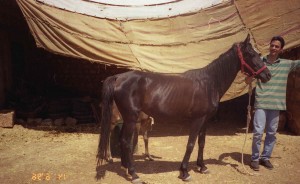Strain of the week: Krush al-Baida goes north
One day in 2006, my friend Hazaim al-Wair and I, intrigued by the addition of “al-Baida” to the strain of many (not all) Kuhaylan al-Krush horses in the Syrian studbook, made a number of phone calls to inquire about the owner of the marbat of Krush al-Baida.
All the roads led to one Shaykh of Shammar by the name of Mayzar al-‘Abd al-Muhsin al-Jarba. Mayzar was a prominent and respected member of the Syrian parliament in the 1940s, where he was known to defend the interests and the causes of all Bedouin tribes, at a time when the lifestyle and economic conditions of the Bedouins were changing rapidly. Mayzar and his son Antar al-Mayzar were associated with nearly every one of the older horses from the Krush al-Baida strain that we could find in Volume I of the Syrian Studbook. We thought we’d start locating Mayzar’s descendants, and eventually located and telephoned a grandson of his, Faysal (ibn Sattam ibn Mayzar ibn ‘Abd al-Muhsin al-Jarba).
 Faysal told us that his branch of the family owned two separate marabit (pl. of marbat) of Kuhaylan al-Krush: an older marbat from the time of al-Sharif Barakat (a ruler of Mecca back in the sixteenth century A.D., at the time all Shammar was still in Najd), and a second, more recent marbat, straight from the al-Dawish head clan of the Mutayr Bedouin tribe. The latter marbat was known as Kuhaylan Krush al-Baida, or simply Krush al-Baida. He also told us that when the older Shaykhs of his family (Antar and Sattam the sons of Mayzar, we gathered) passed away, they left behind young children, to young too inherit. The Krush horses went into the temporary custody of a Shammar Bedouin (some say a former slave) by the name of ‘Iyadah al-Taleb al-Khalaf, also known as al-Qartah. ‘Iyadah took all the horses by force (late 1960s?), and never gave them back to their rightful owners. Today Faysal, his brothers and cousins are still stuggling to retrieve at least one Krush mare from the famed stud of their grandfather..
Faysal told us that his branch of the family owned two separate marabit (pl. of marbat) of Kuhaylan al-Krush: an older marbat from the time of al-Sharif Barakat (a ruler of Mecca back in the sixteenth century A.D., at the time all Shammar was still in Najd), and a second, more recent marbat, straight from the al-Dawish head clan of the Mutayr Bedouin tribe. The latter marbat was known as Kuhaylan Krush al-Baida, or simply Krush al-Baida. He also told us that when the older Shaykhs of his family (Antar and Sattam the sons of Mayzar, we gathered) passed away, they left behind young children, to young too inherit. The Krush horses went into the temporary custody of a Shammar Bedouin (some say a former slave) by the name of ‘Iyadah al-Taleb al-Khalaf, also known as al-Qartah. ‘Iyadah took all the horses by force (late 1960s?), and never gave them back to their rightful owners. Today Faysal, his brothers and cousins are still stuggling to retrieve at least one Krush mare from the famed stud of their grandfather..
The only positive aspect of this unfortunate story was that ‘Iyadah bred the horses he stole to each other, hence keeping them pure. Perhaps he did so as a result of being ostracized by the rest of the tribe and denied access to the tribe’s stallions. Today ‘Iyadah al-Qartah’s horses have some of the highest inbreeding coefficients among desert horses, and several are what Western breeders like to call 4 generations “pure in the strain” of Kuhaylan al-Krushan — “pure in the strain” is a notion that I don’t buy into, although I do recognize that in this case it is the reason why the horses stayed Asil.
Faysal also told us that his grandfather Mayzar gave a Krush mare to one of his relatives, another Shaykh by the name of ‘Atallah al-Nassar al-Fahd al-Jarba, who still breeds them pure until the present day.
Below is the picture of a tiny little Krush al-Baida mare bred by ‘Atallah al-Nassar al-Jarba. She is pictured in a wretched condition, having just been smuggled from Iraq into North eastern Syria a few days before. This is a mare I desperately wanted to buy, on the pressing advice of old horse merchant ‘Abd al-Qadir Hammami. She ended up being sold to a man who owned an ice-cream shop, and twelve years after the events (i was 18 in the pic), the “mare of the ice-cream seller” is still the cause of occasional bickering within my family..
